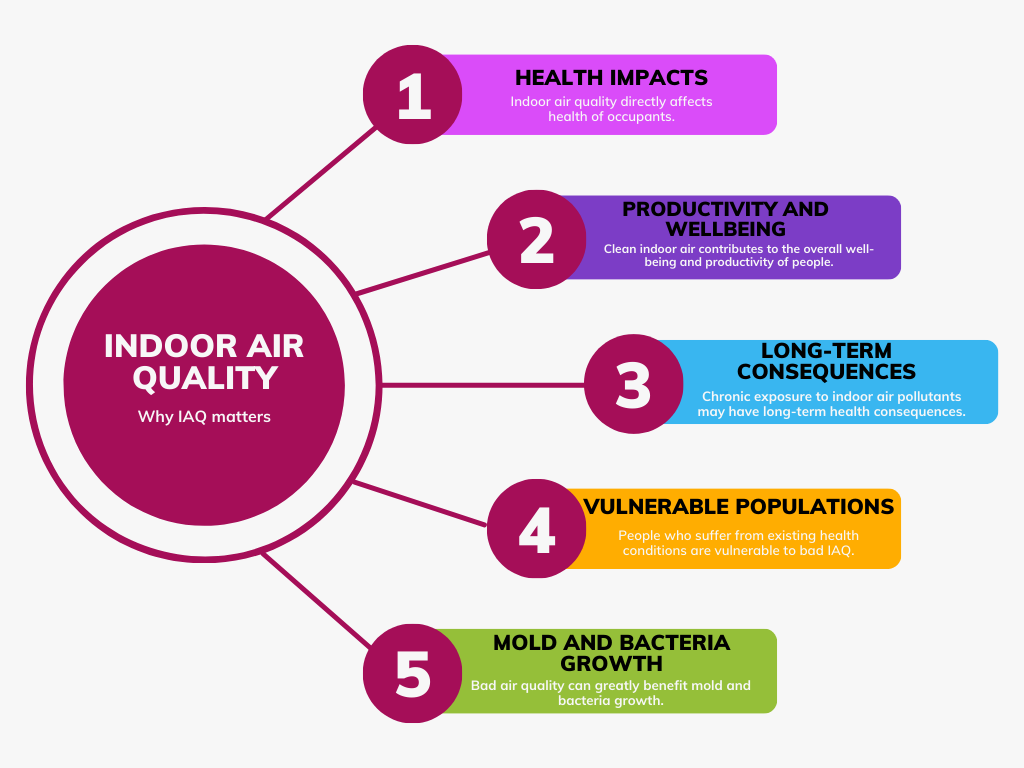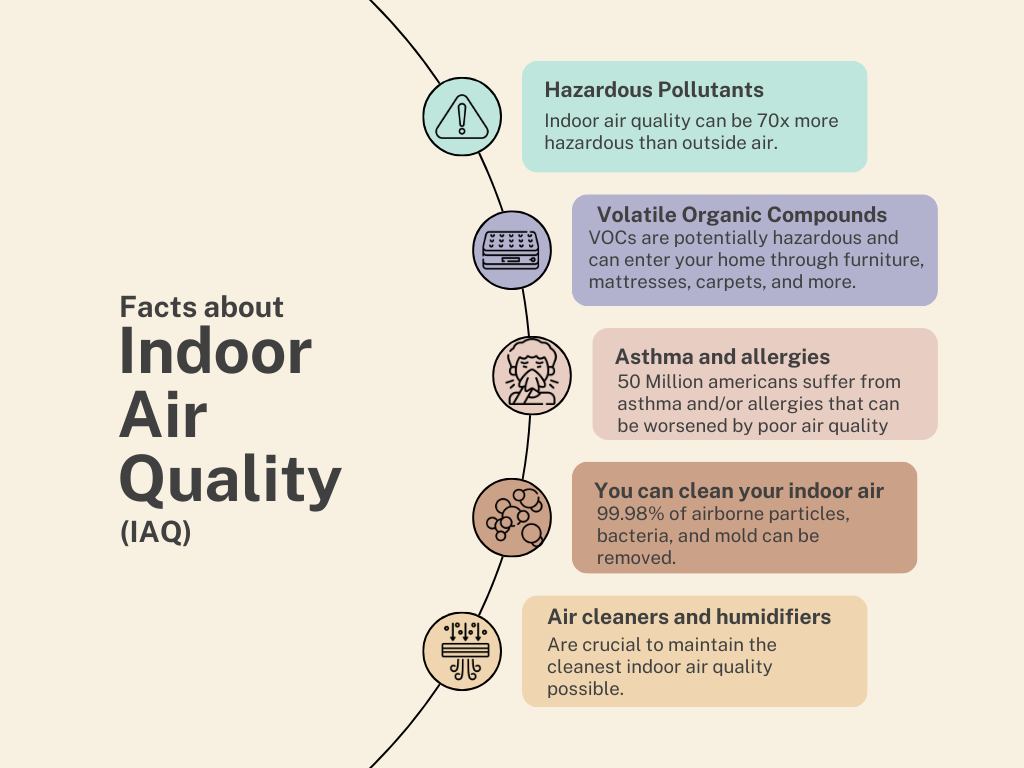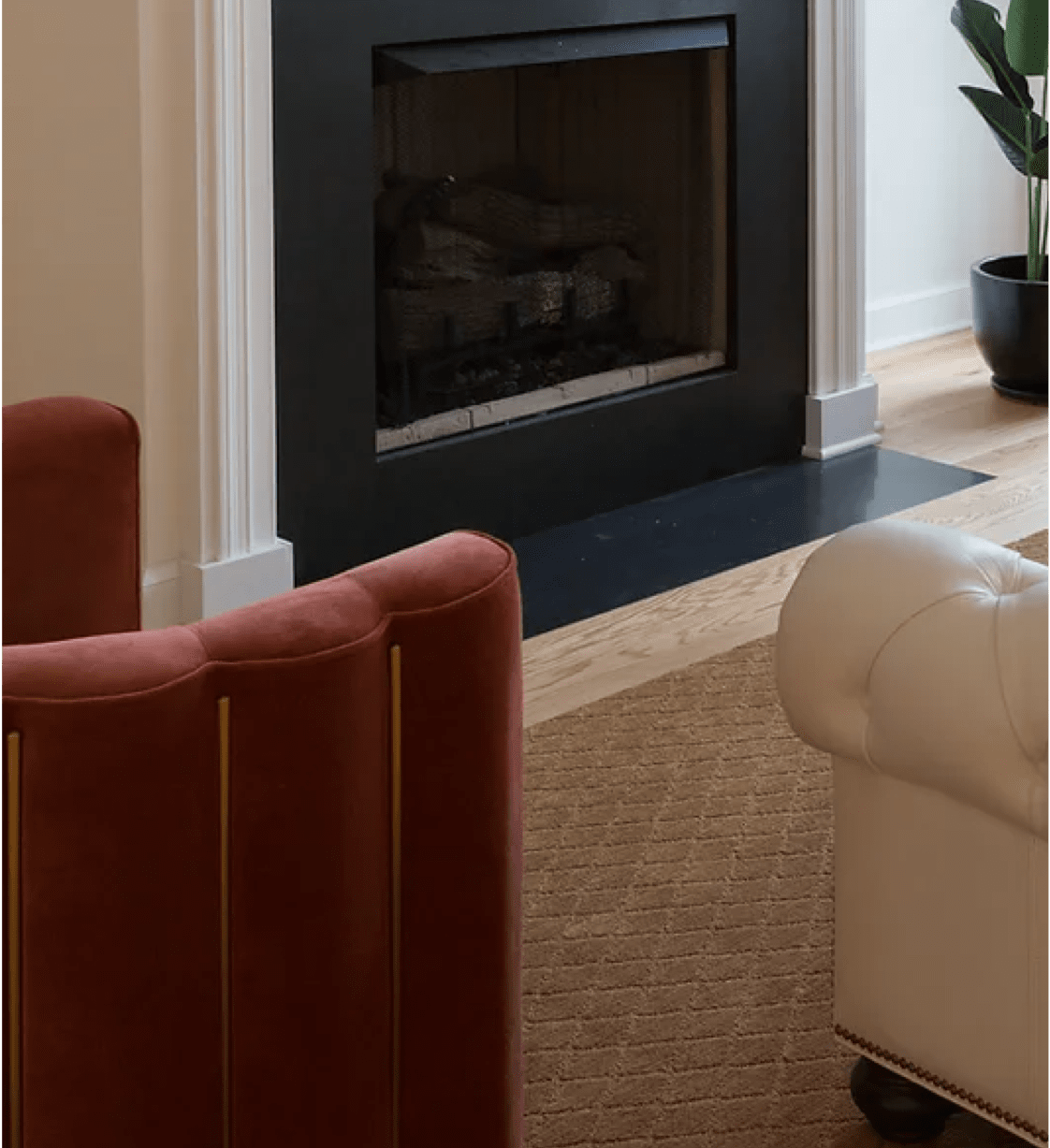Indoor air quality (IAQ) matters significantly because the air we breathe indoors can have profound effects on our health, comfort, and overall well-being. We spend a big percentage of our lifetime indoors, whether at home, work, school, or other enclosed spaces, making the quality of indoor air a crucial factor in supporting a healthy lifestyle.
With 90 percent of our lives spent indoors, most of us don’t give a thought for the quality of the air we breathe inside.

What elements do we have to keep in mind when figuring out IAQ?
- Airborne particulate matter: Tiny particles suspended in the air, dust, pollen, mold spores, and other solid particles. The size of these particles is crucial, as finer particles can penetrate deep into the respiratory system and pose health risks.
- Chemical Pollutants: Indoor air can contain various chemical pollutants, such as volatile organic compounds (VOCs) emitted from household products like paints, cleaning supplies, and furniture. Formaldehyde, benzene, and other chemicals released from building materials and furnishings can contribute to poor IAQ.
- Biological Contaminants: Biological contaminants include bacteria, viruses, mold, and mildew. These can thrive in damp or humid environments and contribute to respiratory issues and allergies. Proper moisture control is essential to mitigate the growth of biological contaminants.
- Humidity levels: Both low and high humidity levels can affect indoor air quality. Low humidity can lead to dry air, causing discomfort and respiratory issues, while high humidity can promote mold growth and the proliferation of dust mites. (Dust mites are very small insect-like pests that feed on dead human skin, they do not bite or burrow into our bodies, but they can cause allergic reactions in some people.
- Ventilation and air exchange rates: Inadequate ventilation allows indoor pollutants to accumulate. Proper ventilation, including the exchange of indoor to outdoor air, helps dilute pollutants and support a healthier indoor environment.
- Temperature: Indoor Temperature influences the comfort of occupants and can also affect the levels of certain pollutants. For Example, high temperatures can increase the release of VOCs from building materials and furnishings.
- Carbon Dioxide (CO2) Levels: Elevated CO2 Levels can indicate insufficient ventilation and may lead to drowsiness, difficulty concentrating, and discomfort. Monitoring and controlling CO2 levels are crucial for maintaining a healthy indoor environment.

With more people working from home and for those not able to completely revamp their current HVAC system, some simple steps can be taken to improve the day-to-day air quality in your home.
- Proper ventilation: Ensure adequate ventilation by opening windows and doors regularly to allow fresh outdoor air to circulate (If you live in a very cold environment and cannot open windows, look down for the other tips!)
- Regular cleaning: Clean dust surfaces often to prevent the buildup of dust mites, pet dander, and other particulate matter. Keep the office area clutter-free to minimize dust and debris accumulation.
- Air filters: If your home’s HVAC has filters do not forget to clean them regularly or replace them as needed. HEPA filters are the best filters to trap fine particulates and allergens from dust and carpets. You can purchase stand-alone Air Purifiers or whole-house air purifiers. Ensure you maintain these filters and keep them clean or replace them per the manufacturer’s suggestion. If your HVAC equipment has filters, Clean or replace filters with HEPA filters to trap fine particulates and allergens from carpets and rugs.
- Indoor Plants: Incorporate indoor plants, as they are nature’s air filtering system, they filter out certain pollutants. Some plants like snake plants and spider plants are known for their air-purifying capabilities, plus they also serve as a great décor!
- Control Humidity: Keep indoor humidity levels between 30-50% to prevent mold growth and dust mites and use dehumidifiers in areas in your home prone to high humidity. Dry air can irritate lung airways, and cause skin problems, dry eyes, sore throats, and more
Keeping your house clean also includes having to keep your IAQ in mind, with clean air, you provide comfort and health and quite possibly reduce sick days that can affect your work. When hiring an architect, this should always be a part of the conversation during the planning and design stages. Whether you wish to renovate or build a new home, given the long-term risk of breathing bad air quality, it is always recommended that you implement smart design within the limitations of your house.
This can pose a challenge, but you’ll be amazed at how many great ideas there are to improve IAQ!
Kristin Hopkins-Clegg, AIA
No Comment
Leave a Comment







